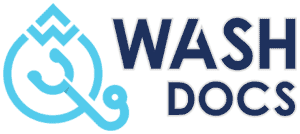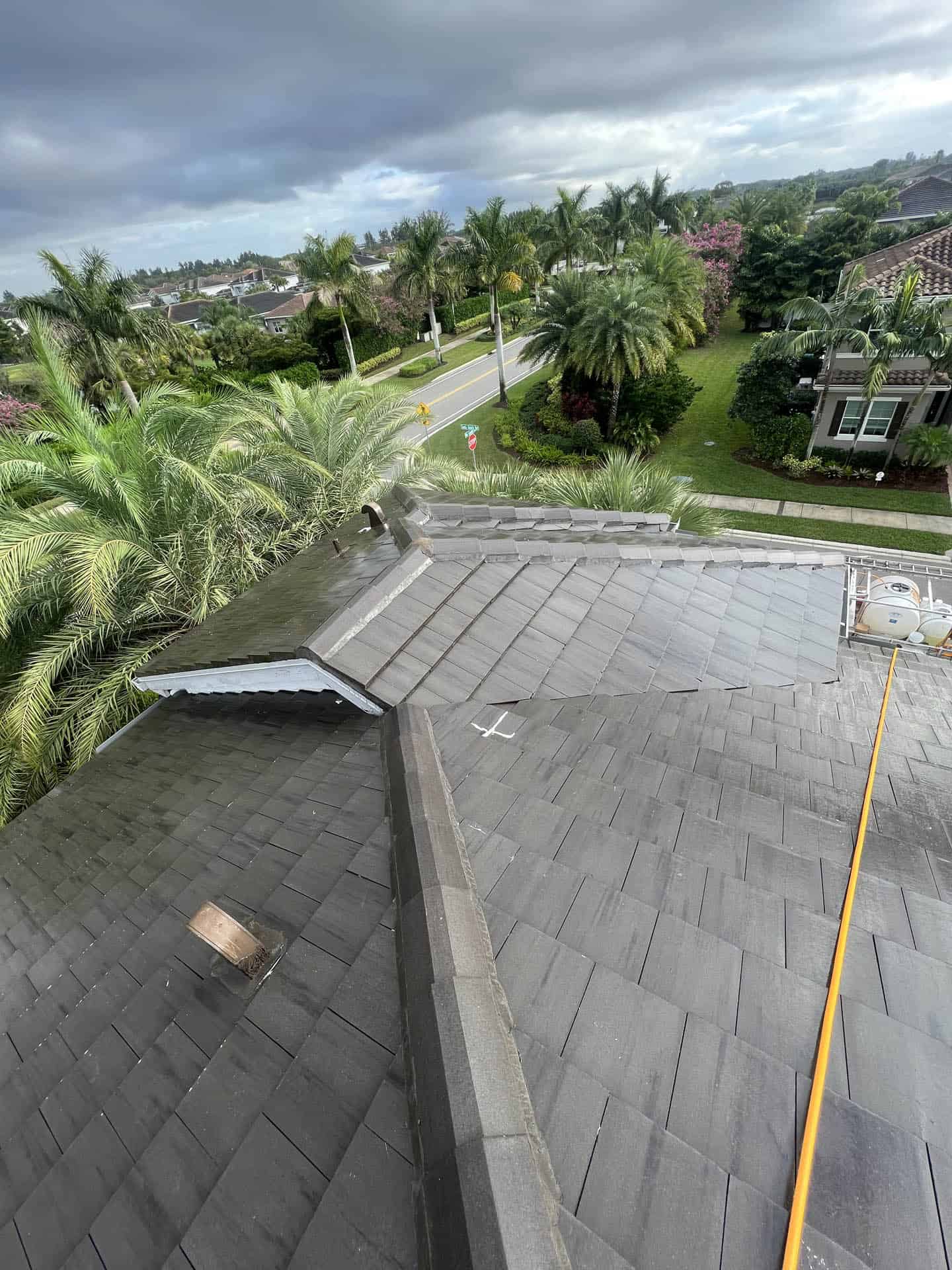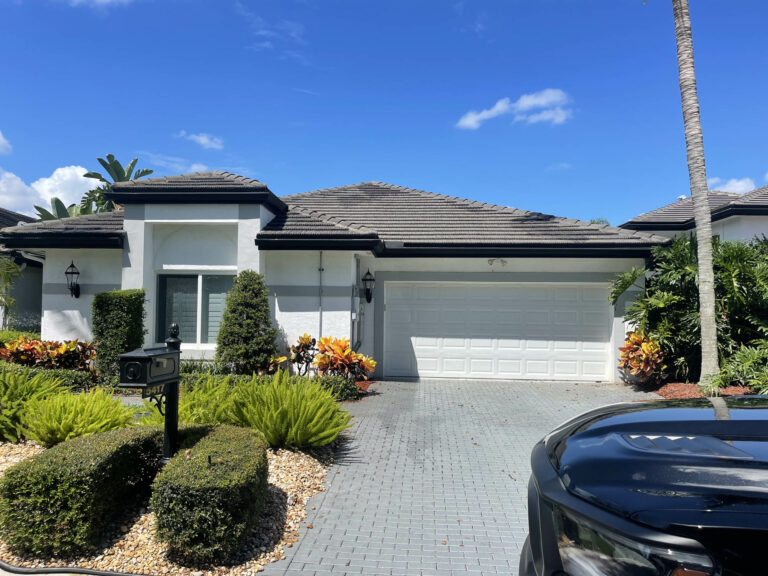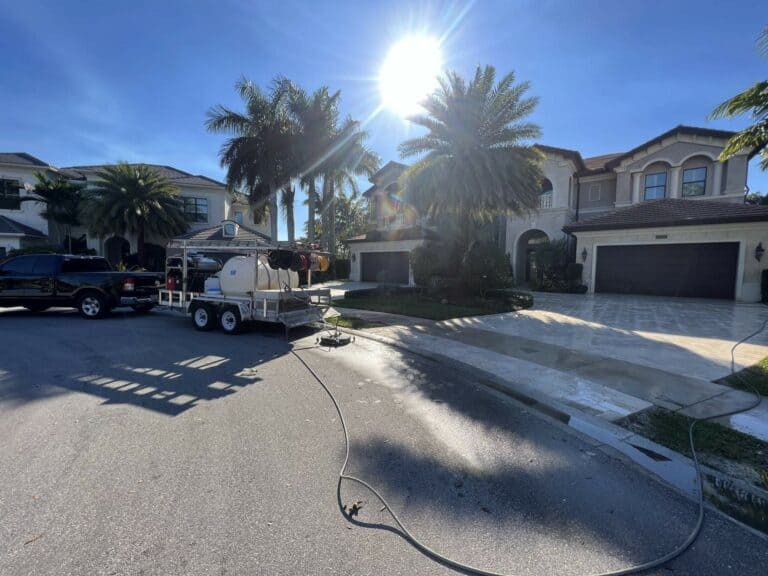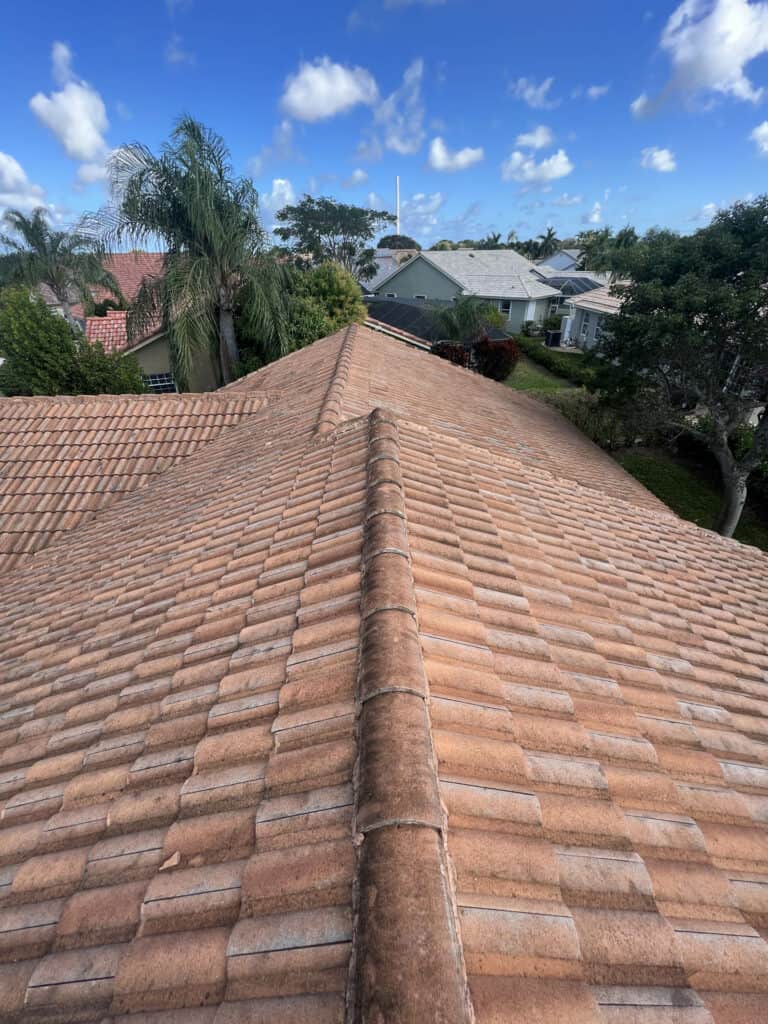Shingle roof cleaning is an essential part of home maintenance that extends the lifespan of your roof and maintains its aesthetic appeal. Over time, shingle roofs can accumulate dirt, debris, and organic growth like algae, moss, and lichen, which can deteriorate the material and lead to costly repairs or replacements. The most effective method for cleaning shingle roofs is often the soft wash technique, which involves applying a low-pressure water spray and specialized cleaning solution to remove these substances without damaging the shingles.
The cleaning solution used typically includes chemicals like sodium hypochlorite or sodium hydroxide, sometimes combined with a surfactant to ensure the solution adequately adheres to and penetrates the roof surface. A shingle roof cleaner, like Sodium hypochlorite, found in household bleach, is highly effective in killing algae, mold, and other organisms. However, these chemicals must be used with caution. They can be harmful if improperly handled, and their runoff needs to be managed properly to prevent harm to plants or contamination of water sources. It’s crucial to wear appropriate protective gear, including gloves and eye protection, and work in a well-ventilated area when handling these chemicals.
While DIY roof cleaning is possible, many homeowners opt to hire professional roof cleaning services due to the potential risks and complexities of the task. Professionals are trained to handle cleaning chemicals safely and know how to clean roofs without causing damage. If you decide to do it yourself, it’s essential to educate yourself on the correct techniques and safety precautions to prevent damage to your roof and potential harm to yourself and the environment. Regular shingle roof cleaning not only improves the appearance of your home but also contributes to a longer-lasting, healthier roof.
Chemical roof cleaning, also known as soft washing, is a method of cleaning roofs using a low-pressure water spray and specialized cleaning solutions. The cleaning solutions usually include chemicals such as sodium hypochlorite (bleach) or sodium hydroxide, often in combination with a surfactant to help the solution stick to and penetrate the roof surface to remove debris and dirt.
This method is especially effective in removing organic matter like algae, mold, mildew, and moss that can accumulate on a roof over time. These organisms can damage the roof material and shorten its lifespan if not removed.
Chemical roof cleaning is generally recommended over high-pressure washing for most roofing materials as it reduces the risk of physical damage to the roof. High-pressure washing can dislodge granules from asphalt shingles, damage tiles, or force water underneath the shingles, leading to leaks.
The process generally involves applying the cleaning solution, allowing it to dwell on the surface to kill and loosen the organisms, and then rinsing it off with low-pressure water.
Safety precautions should be taken when performing chemical roof cleaning, as the chemicals used can be harmful if improperly handled. This includes wearing appropriate protective gear and ensuring that the runoff is properly managed to avoid harming plants or contaminating water sources. Due to these considerations, many homeowners choose to hire professional roof cleaning services to perform this task.
How Can You Tell When Your Roof Shingles Need Cleaning?
Recognizing when your roof shingles need cleaning is a vital part of maintaining your home. Here are some signs that it may be time to clean your roof:
- Dark Stains or Streaks: If you notice dark streaks or stains on your shingles, it’s often a sign of algae or mold growth. These organisms feed on the limestone in shingles, causing discoloration and potential damage over time.
- Moss or Lichen Growth: Moss and lichen retain moisture against the surface of your roof, which can accelerate wear and potentially lead to leaks. If you see green patches or white, crusty growths, it’s time to clean your roof.
- Roof Looks Dirty or Old: General dirt and debris can accumulate on your roof over time, causing it to look dirty or aged. Regular cleaning can restore the appearance of your roof and extend its lifespan.
- Neighbors are Cleaning Their Roofs: Algae, moss, and other organisms can spread from roof to roof, especially in close-knit communities. If your neighbors are cleaning their roofs, it may be a good idea to clean yours as well.
- It’s Been a While Since the Last Cleaning: If you can’t remember the last time your roof was cleaned, or it’s been several years, it’s probably time for a cleaning. Most experts recommend cleaning your roof every two to three years, depending on the climate and the surrounding environment.
Remember, regular roof cleaning not only improves the curb appeal of your home, but also extends the lifespan of your shingles and can prevent costly repairs or replacements in the future. Always consider hiring a professional pressure washing company to help with the roof cleaning process, as improper cleaning can lead to damage.
FAQs About Cleaning Roofs With Shingles
Select A Service Location
How Often Should I Clean My Roof Shingles?
The frequency at which you should clean your roof shingles can depend on several factors, including the climate you live in, the type of trees surrounding your home, and the current condition of your roof.
As a general rule, most experts recommend cleaning your roof shingles every two to three years. However, if your home is situated in a damp, shaded, or wooded area where the roof is more likely to accumulate moss, mold, or algae, you might need to clean your roof more frequently, potentially once a year.
Furthermore, if you notice signs of organic growth such as dark stains, streaks, moss, or lichen on your shingles, you should consider cleaning your roof even if the two to three-year window hasn’t passed. These signs can indicate that your roof’s health is at risk and immediate action is necessary.
It’s important to remember that over-cleaning your roof or using inappropriate methods or harsh chemicals can also damage your shingles or tiles and reduce the overall lifespan of your roof. Therefore, you should always consult with a professional roof cleaning company/pressure washing company to make an accurate assessment based on your specific circumstances to give you advice on your dirty roof.
How Should You Chose the Best Roof Cleaners?
Choosing the best roof cleaner for a shingle roof depends on various factors, including the specific problem you are trying to address, the type of shingles, and safety considerations. A company experienced with pressure washing can give you a great roof wash, but if you want to be proactive, here are some guidelines for shingle roofs to help you choose:
- Identify the Issue: The first step is to identify what you’re trying to remove from your roof. Is it algae, moss, lichen, or just general dirt and debris? Some roof cleaners are more effective at addressing certain problems than others.
- Choose the Right Ingredients: Roof cleaners often contain either sodium hypochlorite (bleach) or sodium hydroxide. Sodium hypochlorite is a powerful disinfectant that effectively kills algae, moss, and mold, but it can lighten the color of your shingles. Sodium hydroxide doesn’t have a bleaching effect, but it can be more corrosive. Be sure to choose a product that’s compatible with your shingles and the organisms you’re trying to remove.
- Check the Concentration: Concentrated roof cleaners can be cost-effective since you can dilute them according to your needs. However, make sure to follow the manufacturer’s instructions to avoid damaging your roof with a too-strong solution.
- Consider Eco-friendly Options: Some roof cleaners are eco-friendlier than others. Look for products marked as biodegradable or non-toxic. These are often safer for the environment and less likely to harm your plants or lawn.
- Look for Easy Application: Roof cleaners come in various forms, from spray bottles to hose-end sprayers. Choose a product that’s easy for you to apply. Some even come as a no-rinse formula, which means you just spray it on and let it do its work.
- Read Reviews: Online reviews can provide valuable information about how well a product works and whether it’s a good value. Look for products with mostly positive reviews from people who have used them on similar roofing materials and problems. The same goes if you plan to higher a pressure washer, read the company reviews online and ask about the shingle roof cleaning solutions they use.
- Ask Professionals: Consider asking a professional pressure washer or a reputable home improvement store for advice on the best roof cleaner for your specific situation. You don’t want to use harsh chemicals that will damage your roof and a typical garden hose probably won’t get the job done on tough stains.
Remember, even the best roof cleaner can cause damage if not used correctly. Always follow the manufacturer’s instructions and consider hiring a professional if your roof is significantly stained or if it’s been a long time since the last cleaning.
Will Stain Remover Work On My Shingle Roof?
Stain removers are indeed effective in cleaning shingle roofs, particularly those designed for outdoor use on surfaces like roofs, decks, and siding. These products are formulated to remove various types of stains, including those caused by algae, moss, mold, and mildew. However, not all stain removers are created equal, and it’s important to choose a product that’s appropriate for your specific roof and the type of stains you’re dealing with like a mildew stain remover to get a completely clean roof.
Roof cleaning products come in several forms, including sprays, concentrates, and even powders. Many contain powerful ingredients like sodium hypochlorite or sodium hydroxide, which are effective at killing and removing organic growths. For milder stains, or for homeowners who prefer a more eco-friendly option, there are also non-toxic, biodegradable roof cleaners on the market. These products are generally safer for the environment and for the person applying the product, but they might not be as effective on severe stains.
When it comes to mildew stain remover, you’ll want to look for a product specifically designed to tackle this issue. Mildew stain removers often contain bleach or other powerful disinfectants that can kill mildew at the source and remove the stains it leaves behind. Clay shingles are also different from asphalt shingles. Clay tile shingles are commonly found in states like florida and pressure washers have to handle them with care.
Remember, while stain removers can be effective, they must be used correctly to avoid causing damage to your shingles or the environment. Always follow the manufacturer’s instructions, wear appropriate protective gear, and rinse your roof and any nearby plants thoroughly after application. If you’re dealing with extensive staining or aren’t comfortable doing the job yourself, consider hiring a professional roof cleaner.
When is the Best Time to Clean My Roof?
The best time to clean your roof is when you notice stains, streaks, or discoloration. It’s important to clean your roof before any significant damage occurs. It’s also best to clean your roof on a dry, sunny day when the temperature is above freezing.
Is Chemical Roof Cleaning Safe?
Yes, chemical roof cleaning is safe when done by a professional. The cleaning solutions used are specially formulated to be safe for use on roofs and to not damage the surface. However, it’s important to hire a professional who has the training and experience necessary to do the job safely.
How Much Does Chemical Roof Cleaning Cost On A Shingle Roof?
The cost of chemical roof cleaning can vary depending on the size of your roof, the degree of staining or discoloration, and the type of roofing material. It’s best to get a detailed estimate from a professional soft wash roof cleaning company to get an accurate idea of the cost.
What is the most effective chemical for roof cleaning?
Sodium hypochlorite is often considered the most effective chemical for roof cleaning. It’s a primary component in many professional roof cleaning solutions due to its ability to eliminate algae, mildew, and moss.
Which chemical is optimal for cleaning a shingle roof?
Different forms of bleach mixed with water are accepted as the best choice for cleaning shingle roofs. This chemical is effective in killing algae and other organisms that can deteriorate shingles over time.
What Are Different Types Of Shingle Roofs That Require Pressure Cleaning
Asphalt Shingles
What Are They?
Asphalt shingles are the most common type of roofing material in the United States. They are made from a base of either organic felt or fiberglass, coated with asphalt.
Pros and Cons
- Pros: Affordable, easy to install, and come in various colors.
- Cons: Less durable compared to other types, not eco-friendly.
Best Suited For
Ideal for residential homes in areas without extreme weather conditions.
Wood Shingles
What Are They?
Wood shingles are typically made from cedar, redwood, or pine.
Pros and Cons
- Pros: Natural look, energy-efficient, and relatively durable.
- Cons: High maintenance, not fire-resistant unless treated.
Best Suited For
Best for homes in rustic settings or as part of specific architectural designs.
Metal Shingles
What Are They?
Metal shingles are made from various metals including aluminum, copper, and steel.
Pros and Cons
- Pros: Long-lasting, fire-resistant, and energy-efficient.
- Cons: Expensive upfront cost, may dent easily.
Best Suited For
Ideal for homes in areas prone to wildfires or extreme weather conditions.
Slate Shingles
What Are They?
Slate shingles are made from natural slate rock, making them one of the most durable roofing materials.
Pros and Cons
- Pros: Extremely durable, fire-resistant, and eco-friendly.
- Cons: Very heavy, expensive, and require professional installation.
Best Suited For
Best for high-end homes and historic buildings.
Tile Shingles
What Are They?
Tile shingles are often made from clay or concrete and are commonly used in Spanish-style homes.
Pros and Cons
- Pros: Extremely durable, fire-resistant, and aesthetically pleasing.
- Cons: Heavy and expensive.
Best Suited For
Ideal for homes with a Mediterranean or Spanish architectural style.
Rubber Shingles
What Are They?
Rubber shingles are made from recycled tires and other rubber materials.
Pros and Cons
- Pros: Eco-friendly, durable, and low maintenance.
- Cons: Limited color options, may not be allowed in some areas.
Best Suited For
Great for environmentally-conscious homeowners.
Composite Shingles
What Are They?
Composite shingles are made from a blend of various materials like fiberglass, asphalt, and recycled paper.
Pros and Cons
- Pros: Durable, eco-friendly, and come in various styles.
- Cons: Can be expensive.
Best Suited For
Ideal for those looking for a balance between cost and durability.
Solar Shingles
What Are They?
Solar shingles serve as both a roof covering and a solar panel to generate electricity.
Pros and Cons
- Pros: Energy-efficient, aesthetically pleasing.
- Cons: Expensive upfront cost, may require additional structural support.
Best Suited For
Perfect for homeowners looking to invest in renewable energy.
Get Your Tile or Shingle Roof Cleaned Today!
aesthetic appeal of your home and extending the longevity of your roof. Each type of roof material, whether it’s tile or shingle, has its unique cleaning requirements and challenges, and it’s essential to approach the cleaning process with these considerations in mind.
Tile roofs, often made from clay or concrete, are durable and can withstand harsh weather conditions, but they can still accumulate dirt, algae, moss, and other organic growths that can impact their lifespan and appearance. Gentle, low-pressure washing techniques, often combined with effective cleaning solutions, are key to maintaining the integrity and beauty of tile roofs.
Shingle roofs, particularly those made of asphalt, can be more delicate, and they are prone to similar organic growths. Cleaning solutions based on sodium hypochlorite or sodium hydroxide are generally effective at dealing with these issues, but the use of high-pressure washing techniques should be avoided to prevent damage to the shingles.
In all cases, safety should be the top priority when cleaning roofs. The chemicals used in cleaning solutions can be harmful if not handled correctly, and the act of climbing and moving around on a roof carries inherent risks. Regular cleaning by professionals experienced with the specific type of roof can be a wise investment in the long-term health of the roof and the home it protects.
Finally, while regular cleaning is important, it should be balanced with the need to avoid over-cleaning, which can also lead to wear and tear. As a homeowner, it’s about striking that balance, being proactive about regular maintenance, and recognizing when it’s time to call in the professionals to ensure your roof remains in peak condition for years to come.
By hiring a professional pressure washing company like Wash Docs you can ensure that the job is done safely and effectively, and you can enjoy a clean, beautiful roof for years to come. Contact us today to schedule your chemical roof cleaning appointment.
